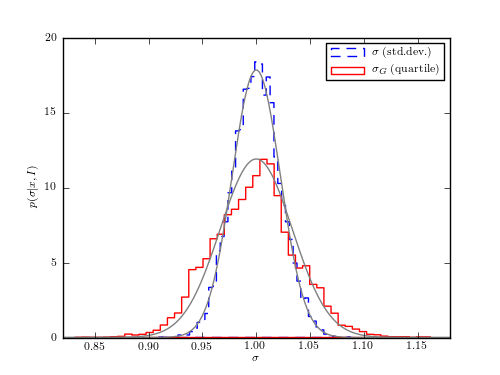Bootstrap Calculations of Error on Mean¶
Figure 4.3.
The bootstrap uncertainty estimates for the sample standard deviation
 (dashed line; see eq. 3.32) and
(dashed line; see eq. 3.32) and  (solid line;
see eq. 3.36). The sample consists of N = 1000 values drawn from a Gaussian
distribution with
(solid line;
see eq. 3.36). The sample consists of N = 1000 values drawn from a Gaussian
distribution with  and
and  . The bootstrap
estimates are based on 10,000 samples. The thin lines show Gaussians with
the widths determined as
. The bootstrap
estimates are based on 10,000 samples. The thin lines show Gaussians with
the widths determined as  (eq. 3.35) for
(eq. 3.35) for
 and
and  (eq. 3.37) for
(eq. 3.37) for  .
.

# Author: Jake VanderPlas
# License: BSD
# The figure produced by this code is published in the textbook
# "Statistics, Data Mining, and Machine Learning in Astronomy" (2013)
# For more information, see http://astroML.github.com
# To report a bug or issue, use the following forum:
# https://groups.google.com/forum/#!forum/astroml-general
import numpy as np
from scipy.stats import norm
from matplotlib import pyplot as plt
from astroML.resample import bootstrap
from astroML.stats import sigmaG
#----------------------------------------------------------------------
# This function adjusts matplotlib settings for a uniform feel in the textbook.
# Note that with usetex=True, fonts are rendered with LaTeX. This may
# result in an error if LaTeX is not installed on your system. In that case,
# you can set usetex to False.
from astroML.plotting import setup_text_plots
setup_text_plots(fontsize=8, usetex=True)
m = 1000 # number of points
n = 10000 # number of bootstraps
#------------------------------------------------------------
# sample values from a normal distribution
np.random.seed(123)
data = norm(0, 1).rvs(m)
#------------------------------------------------------------
# Compute bootstrap resamplings of data
mu1_bootstrap = bootstrap(data, n, np.std, kwargs=dict(axis=1, ddof=1))
mu2_bootstrap = bootstrap(data, n, sigmaG, kwargs=dict(axis=1))
#------------------------------------------------------------
# Compute the theoretical expectations for the two distributions
x = np.linspace(0.8, 1.2, 1000)
sigma1 = 1. / np.sqrt(2 * (m - 1))
pdf1 = norm(1, sigma1).pdf(x)
sigma2 = 1.06 / np.sqrt(m)
pdf2 = norm(1, sigma2).pdf(x)
#------------------------------------------------------------
# Plot the results
fig, ax = plt.subplots(figsize=(5, 3.75))
ax.hist(mu1_bootstrap, bins=50, normed=True, histtype='step',
color='blue', ls='dashed', label=r'$\sigma\ {\rm (std. dev.)}$')
ax.plot(x, pdf1, color='gray')
ax.hist(mu2_bootstrap, bins=50, normed=True, histtype='step',
color='red', label=r'$\sigma_G\ {\rm (quartile)}$')
ax.plot(x, pdf2, color='gray')
ax.set_xlim(0.82, 1.18)
ax.set_xlabel(r'$\sigma$')
ax.set_ylabel(r'$p(\sigma|x,I)$')
ax.legend()
plt.show()
